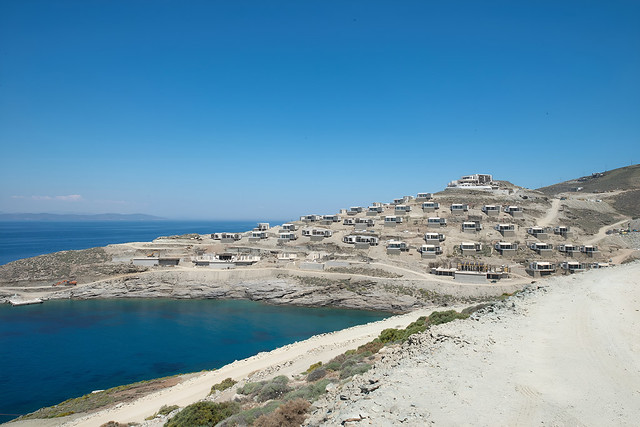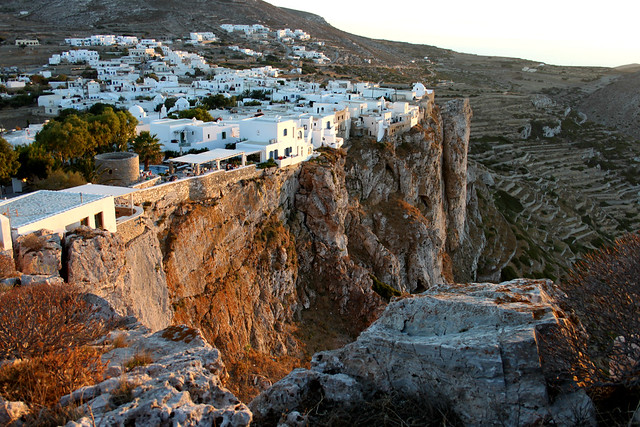Cycladic Islands, notably Sifnos, Serifos and Folegandros, Greece
Spreading across the Aegean Sea, the Cyclades archipelago comprises around 220 islands, among which Delos stands proudly as a UNESCO World Heritage site. In addition to the historical significance of the Aegean Sea, a combination of natural elements and traditional architecture defines the Cycladic landscape. The mountainous and rugged terrain of the islands contributes to their distinctive character, offering captivating and picturesque vistas that define the region’s scenery. Another notable element of the Cycladic landscape is the presence of agricultural lands hosting small rural houses and utility structures like windmills or farms. In most of the islands there are dry stone walls, which allow cultivation on lands with steep slopes. The ports of Cyclades also contribute to its character. In some islands, the port is located in the main village while in others a narrow road connects both places.
The Cyclades, renowned for their unique charm and rich culture, find themselves grappling with a myriad of challenges posed by the surge in tourism development and rampant construction. Despite driving economic growth, this brings along a host of environmental, cultural, and social issues, including the degradation of natural resources, damage to cultural and natural heritage, water scarcity, waste management problems, and socio-economic disparities. The islands are at risk of losing their exceptional and authentic character as increasing tourist-oriented construction threatens to overshadow their inherent allure.
Of particular concern are the smaller island destinations within the Cyclades, which bear the brunt of overtourism. The strain on infrastructure and the escalating demand for accommodation present significant challenges. The clamour for new constructions beyond settlement boundaries has reached unprecedented levels, with data from the National Statistical Authority revealing a steady rise in new building permits from 916 in 2018 to 1,280 in 2022. The built square metres, escalating from 291,722 sqm in 2018 to 419,232 sqm in 2022, underscore the intensification of construction activities.
The nomination of the Cyclades, in particular of the islands of Sifnos, Serifos and Folegandros, to the 7 Most Endangered Programme 2024 was made by Elliniki Etairia – Society for the Environment and Cultural Heritage. The nominator advocates for strategic policy-based measures to address the pressing issues in the Cyclades, proposing a comprehensive approach to safeguard the islands’ integrity. Immediate priorities include establishing the Special Spatial Plan for Tourism to regulate and manage activities, along with instituting a binding Regional Spatial Plan of South Aegean. The proposal also emphasises the need for Local Urban Plans to define landscape enhancement zones, collaborating between the Ministry of Tourism and the Ministry of Environment for policy convergence, and creating specific institutional regulations to integrate carrying capacity into spatial planning.
Focusing on three Cycladic islands – Sifnos, Serifos, and Folegandros – the nominator initiated impactful actions. Proposals submitted during public consultations address critical aspects such as tourism investment placement, overbuilding, and protection of natural and agricultural areas. An awareness campaign, launched in 2013, advocates for the Carrying Capacity of each island, aiming to preserve their natural and cultural environments and promote sustainable practices. Furthermore, the Sustainable Aegean Programme, initiated in 2004, serves as a platform for awareness activities, consultations on development models, and interventions to ensure the islands’ sustainable future.
The nominator envisions utilising the 7 Most Endangered Programme to raise awareness about uncontrolled development and influencing government policies for improved urban planning within the islands. Supporters in this campaign include the mayors of three especially affected islands: Serifos, Sifnos and Folegandros.
The Advisory Panel stated: “Via the 7 Most Endangered Programme, the nominator aims at the international recognition of the threat posed on the important and sensitive Cycladic area, as well as the promotion of common and successful practices for the protection of this European cultural asset called Cycladic landscape.”



